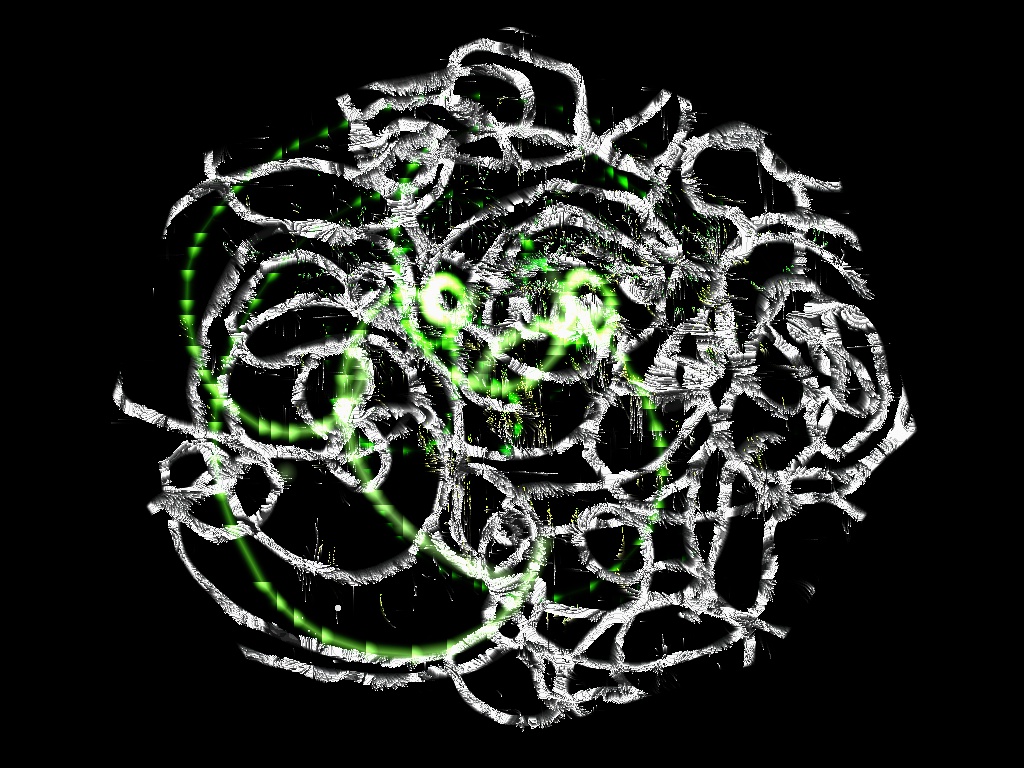Salah el Ouergli & Slim Molki (Stembali live music), Farah Bahri & Yukao Nagemi (performative drawing)

Lights and Resonances of Stambeli is a celebration of the Stambeli ritual through a video-projection on the floor combined with action painting and digital effects. The live drawing of the two visual performers Farah Bahri and Yukao Nagemi is empowered by the traditional Stambeli music inheriting central African roots of vaudoo ceremonies and performed live by internationally famous musician Salah el Ouergli accompanied by Slim Molki. The poetic narration is made of four songs and their associated live constructed pictures. It first evokes the maritime origin of the holy figure of Sidi Mansour, and then the audience experience three symbolic rituals of the traditional Stambeli ceremony: the candle lighting, the sacrifice, and the trance/dance.
The audiovisual performance offers an emotional journey by associating the rhythms of the music with the magic of the live digital paintings. The digital media, the live (almost danced) drawing performance and the traditional trance music of the ghombri and chakh-chakh blend in a harmonious way, reflecting on the spirit of the ancient shamanic ceremony. Certainly, the enchantment of the digital setup (in which the technical components are as much hidden as possible), contribute to the emotional impact of the work, together with the repetitive, and almost hypnotic power of the music. The ground based graphical performance avoids the distance and the domination of a screened video-projection. By locating the graphics horizontally and next to the audience, it relates less to the “société du spectacle” screen culture. It evokes the contact of the Stambeli dancers with the floor and the trajectories of their dance. It allows for a combination of dance-based painting on the floor and pixelized figures and traces.
Since three drawing and painting surfaces are available — a digital tablet, a camera-captured paper drawing, and the surface of the floor covered with paper — the two visual performers can simultaneously contribute to the graphical rendering by acting together on the floor or acting on different surfaces. Since the digital effects added to the tablet and camera-captured drawings are pulsed by the music, the four performers (2 visual artists and 2 musicians) are perceived by the audience as part of the same live audiovisual band, working closely together, coordinating through eye contact, and pulsing on the same tempo. By avoiding any illustrative or decoration feeling, and by evoking the dual visual and auditive impression of the rituals in a cohesive way, it invites the audience to participate in an actual ceremony by receiving its spiritual power.
The event has witnessed a very good feedback from the audience. It has been well covered by the Tunisian media: an interview at the evening news of the National Tunisian 2 television, an interview part #1 and part #2 on the alternative program Radio Misk and on the cultural program RTCI, a full documentary (28 mns) on the Radio Misk website, and some other more private reports. Even though the event has only been diffused on the Tunisian territory, we are convinced that it could raise the interest of an audience other Maghrebin countries which have rituals like Stambeli (Diwan in Algeria and Gnaouas in Marocoo), or of audience from other parts of the world because of its strong ethnical roots.
I would like to thank all the community of volunteers and the curators and organizers of the events for their continuous and warm support. And a big thank you to my artist partners: Farah, Salah, and Slim who gave the best of themselves for this project! I am very grateful to each of you. I am so happy to have worked with so wonderful people.
Category: live audio-visual performance (digitally augmented performative drawing and Stambeli music) — duration 30′
Presented at Dar Lasram, for INTERFERENCE 2018, Light festival Tunis (curators: Bettina Pelz & Aymen Gharbi), 6-9 September 2018.
Music performance: Salah el Ouergli & Slim Molki (Stembali live music)
Visual performance: Farah Bahri & Yukao Nagemi (performative drawing)
Stage Managers: Lamia Barbouch & Aymen Naimi
Video: Aymen Naimi (capture) & Yukao Nagemi (editing)
Production studios: GRAV at INTERFERENCE 2018 (artistic direction): Salma Kossentini & Dora Touati (curators), Youssef Skhiri, Houcem Bibo, Hassen Saadi, Aya Omri, Karim Hatira, Hakhim Mnasri, Rayen Touati, Selim Mrad… (assistants) and Design El Warsha (production): Hedy Zoghlami, Lotfi Haziri, Xhouloud Benzarti, Yassine…
Diffusion: Dar Lasram Association pour la Sauvegarde de la Médina et de Protection de l’Environnement, Many thanks to Zargha
Digital graphics: Porphyrograph / sound analysis: pure data
References
Matthieu Hagene. 2011. Stambeli / Le spleen du yenna {VOSTF}. Vimeo.
Amira Hassnaoui. 2017. Stambeli Awakening: Cultural Revival and Musical Amalgam in Post Revolution Tunisia. PhD Thesis. Bowling Green State University. PDF.
Richard Jankowsky. 2010. Stambeli: Music, Trance, and Alterity in Tunisia. Chicago and London: The University of Chicago Press.
Sarah Soull. 2016. Can Stambeli, the Spiritual Music of Tunisia, Be Saved? Noisey/VICE.